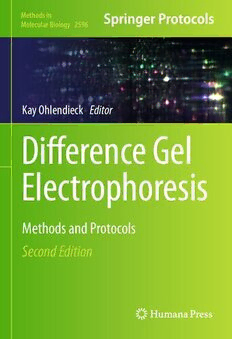Table Of ContentMethods in
Molecular Biology 2596
Kay Ohlendieck Editor
Diff erence Gel
Electrophoresis
Methods and Protocols
Second Edition
M M B
ETHODS IN OLECULAR IO LO GY
SeriesEditor
JohnM.Walker
School of Lifeand MedicalSciences
University ofHertfordshire
Hatfield, Hertfordshire, UK
Forfurther volumes:
http://www.springer.com/series/7651
For over 35 years, biological scientists have come to rely on the research protocols and
methodologiesinthecriticallyacclaimedMethodsinMolecularBiologyseries.Theserieswas
thefirsttointroducethestep-by-stepprotocolsapproachthathasbecomethestandardinall
biomedicalprotocolpublishing.Eachprotocolisprovidedinreadily-reproduciblestep-by-
step fashion, opening with an introductory overview, a list of the materials and reagents
neededtocompletetheexperiment,andfollowedbyadetailedprocedurethatissupported
with a helpful notes section offering tips and tricks of the trade as well as troubleshooting
advice. These hallmark features were introduced by series editor Dr. John Walker and
constitutethekeyingredientineachandeveryvolumeoftheMethodsinMolecularBiology
series. Tested and trusted, comprehensive and reliable, all protocols from the series are
indexedinPubMed.
Difference Gel Electrophoresis
Methods and Protocols
Second Edition
Edited by
Kay Ohlendieck
Maynooth University, Maynooth, Ireland
Editor
KayOhlendieck
MaynoothUniversity
Maynooth,Ireland
ISSN1064-3745 ISSN1940-6029 (electronic)
MethodsinMolecularBiology
ISBN978-1-0716-2830-0 ISBN978-1-0716-2831-7 (eBook)
https://doi.org/10.1007/978-1-0716-2831-7
©TheEditor(s)(ifapplicable)andTheAuthor(s),underexclusivelicensetoSpringerScience+BusinessMedia,LLC,part
ofSpringerNature2023
Thisworkissubjecttocopyright.AllrightsaresolelyandexclusivelylicensedbythePublisher,whetherthewholeorpart
of the material is concerned, specifically the rights of translation, reprinting, reuse of illustrations, recitation,
broadcasting,reproductionon microfilmsorinanyotherphysicalway,andtransmissionorinformation storageand
retrieval,electronicadaptation, computersoftware,orbysimilar ordissimilar methodologynow knownorhereafter
developed.
Theuseofgeneraldescriptivenames,registerednames,trademarks,servicemarks,etc.inthispublicationdoesnotimply,
evenintheabsenceofaspecificstatement,thatsuchnamesareexemptfromtherelevantprotectivelawsandregulations
andthereforefreeforgeneraluse.
Thepublisher,theauthors,andtheeditorsaresafetoassumethattheadviceandinformationinthisbookarebelievedto
betrueandaccurateatthedateofpublication.Neitherthepublishernortheauthorsortheeditorsgiveawarranty,
expressedorimplied,withrespecttothematerialcontainedhereinorforanyerrorsoromissionsthatmayhavebeen
made.Thepublisherremainsneutralwithregardtojurisdictionalclaimsinpublishedmapsandinstitutionalaffiliations.
ThisHumanaimprintispublishedbytheregisteredcompanySpringerScience+BusinessMedia,LLC,partofSpringer
Nature.
Theregisteredcompanyaddressis:1NewYorkPlaza,NewYork,NY10004,U.S.A.
Preface
TheaimofthissecondeditionofDifferenceGelElectrophoresisistoprovideacomprehensive
updateoftechnicaldevelopmentsandnovelbioanalyticalapplicationsofthiskeymethodof
mass spectrometry-based proteomics. Two-dimensional gel electrophoresis is one of the
mostfrequentlyusedproteinseparationtechniquesinthebiologicalsciencesandproteomic
investigations.
DifferenceGelElectrophoresisemploysthedirectlabelingofproteomeswithfluorescent
dyesprior tolarge-scalegelelectrophoreticseparationenablinghigh-throughputcompara-
tive analyses. Labeling of two or more samples with different fluorescent dyes followed by
separationonthesametwo-dimensionalgelsystemeliminatesgel-to-gelvariations,making
this advanced separation technique a robust and highly suitable method for proteomic
profilingsurveyswithdiversebiologicalapplications.
Difference Gel Electrophoresis presents an introduction to the development of this
method and outlines the principles of differential protein labeling and two-dimensional
gel electrophoresis. The bioanalytical integration of the difference gel electrophoresis tech-
nique into optimized proteomic workflows using advanced mass spectrometry for protein
identificationisprovided,aswellasdetailedstep-by-stepprotocolsfortheapplicationofthis
methodinbasicbiologicalresearchandappliedbiomarkerdiscovery.Essentialbioinformat-
ics tools used routinely in systems biology and standard biochemical and cell biological
approaches for the independent verification of proteomic data sets are described. Detailed
protocols of difference gel electrophoresis applications are provided for a wide range of
systematicproteomicapplicationsinbasicbiology,pathobiology,andappliedbiochemistry.
Following an introduction into the versatility of two-dimensional gel electrophoresis
(Chap.1),thisneweditionoutlinestheconceptoftop-downproteomicstostudyindividual
proteoforms (Chap. 2) and discusses analysis software used in protein identification
approaches (Chap. 3). A section on the application of difference gel electrophoresis gives
detaileddescriptionsofnativegelelectrophoresisforthequantitativeandfunctionalanalysis
of protein interactions (Chap. 4), comparative fluorescence gel electrophoresis (Chap. 5),
the identification of ubiquitination associated proteins (Chap. 6), the characterization of
phosphorylationasakeypost-translationalmodification(Chap.7),biomarkerdiscoveryin
blood cancers (Chap. 8), studying formalin-fixed and paraffin-embedded tissue sections
(Chap.9),thefractionationandcharacterizationofserum/plasmasamples(Chap.10),the
simultaneous analysis of several biological specimens on the same two-dimensional gel
(Chap. 11), and the proteomic identification of saliva proteins as non-invasive diagnostic
biomarkers(Chaps.12and13).
An extensive section of Difference Gel Electrophoresis on comparative tissue proteomics
outlinesdetailedprotocolsonthegel-basedanalysisofclinicalspecimens(Chap.14),animal
tissue (Chap. 15), liver tissue from animal models (Chaps. 16 and 17), testis tissue
(Chap. 18), human biopsy material (Chap. 19), subcellular muscle fractions (Chap. 20),
andfishtissues(Chap.21).Thedescriptionofauxiliarymethodsofdifferencegelelectropho-
resis includes sample preparation, protein determination, protein digestion, subcellular
fractionation, immunodepletion of abundant protein species prior to gel electrophoretic
analysis, and an overview of useful bioinformatics analysis tools (Chaps. 22, 23, 24, 25,
and26).
v
vi Preface
For the independent confirmation of key findings from gel-based proteomic studies,
various routine biochemical and cell biological techniques are employed. The most fre-
quently used verification approaches are described in a separate section that outlines the
usefulness and applications of enzyme assays (Chaps. 27 and 28), immunoblot analysis
(Chap. 29), immunofluorescence microscopy (Chap. 30), and histological and histochem-
icalmicroscopy(Chap.31)inmodernproteomics.
Maynooth,Ireland KayOhlendieck
Contents
Preface ..................................................................... v
Contributors................................................................. xi
PART I INTRODUCTION
1 Two-DimensionalGelElectrophoresisand2D-DIGE........ ....... ........ 3
PaulaMeleady
PART II DIFFERENCE GEL ELECTROPHORESIS
2 Top-DownProteomicsandComparative2D-DIGEAnalysis......... ........ 19
KayOhlendieck
3 DIGEAnalysisSoftwareandProteinIdentificationApproaches....... ........ 39
PaulDowling
PART III DIGE APPLICATIONS
4 NativeDIGEforQuantitativeandFunctionalAnalysisofProtein
Interactomes ....... ....... ........ ....... ....... ........ ....... ..... ... 53
DikshaDaniandNorbertA.Dencher
5 ComparativeTwo-DimensionalFluorescenceGelElectrophoresis .... ...... .. 71
DoreenAckermannandSimoneK¨onig
6 IdentificationofUbiquitination-AssociatedProteinsUsing2D-DIGE......... 83
PaulDowlingandDespinaBazou
7 DIGE-BasedPhosphoproteomicAnalysis.... ....... ........ ....... ........ 97
TarasStasykandLukasAlfonsHuber
8 DIGE-BasedBiomarkerDiscoveryinBloodCancers......... ....... ........ 105
KatieDunphyandPaulDowling
9 DIGESaturationLabelingforScarceAmountsofProtein
fromFormalin-FixedParaffin-Embedded(FFPE)Tissue...... ....... ........ 113
PaulDowling
10 DIGEAnalysisofProteoMiner™FractionatedSerum/PlasmaSamples ...... . 119
SandraMurphyandPaulDowling
11 Comparative3-Sample2D-DIGEAnalysisofSkeletalMuscles ....... ........ 127
KayOhlendieck
12 ProteomicIdentificationofSalivaProteinsasNoninvasive
DiagnosticBiomarkers ..... ........ ....... ....... ........ ....... ........ 147
EleanorM.O’Sullivan,PaulDowling,DieterSwandulla,
andKayOhlendieck
13 AnalysisoftheSalivaProteomeUsing2D-DIGE.... ........ ....... ........ 169
PaulDowlingandEleanorM.O’Sullivan
vii
viii Contents
PART IV COMPARATIVE DIGE TISSUE PROTEOMICS
14 DIGEAnalysisofClinicalSpecimens........ ....... ........ ....... ........ 177
CeciliaGelfiandDanieleCapitanio
15 DIGEAnalysisofAnimalTissues .... ....... ....... ........ ....... ........ 201
AlessioDiLuca,RuthHamill,AnneMariaMullen,
andGiulianoElia
16 2D-DIGEProteomicAnalysisofMouseLiverWithin1Week........ ........ 217
ShotaroKamataandIsaoIshii
17 2D-DIGEAnalysisofLiverDiseaseinMice......... ........ ... .... ...... .. 231
A¨ıshaCallebaut,RitaDerua,LutOverbergh,
andVeerleJanssens
18 Two-DyeVersusThree-DyeDIGEforComparativeTestis
TissueProteomicAnalysis........... ....... ....... ........ ....... ........ 245
AshlingHolland
19 Two-CyDye-Based2D-DIGEAnalysisofAgedHumanMuscle
BiopsySpecimens.......... ........ ....... ....... ........ ....... ........ 265
KayOhlendieck
20 IdentificationofSubproteomicMarkersforSkeletal
MuscleProfiling.... ...... ....... .. ... .... ....... ........ ....... ........ 291
PaulDowling,StephenGargan,DieterSwandulla,
andKayOhlendieck
21 DIGEAnalysisofFishTissues....... ....... ....... ........ ....... ........ 303
JoannaNynca,MariolaA.Dietrich,andAndrzejCiereszko
PART V AUXILIARY DIGE METHODS
22 SamplePreparationandProteinDetermination
for2D-DIGEProteomics........... ....... ..... .. ...... .. ..... .. ........ 325
StephenGarganandKayOhlendieck
23 ProteinDigestionfor2D-DIGEAnalysis .... ....... ........ ....... ........ 339
SandraMurphyandKayOhlendieck
24 SubcellularFractionationforDIGE-BasedProteomics ....... ....... ........ 351
SandraMurphy
25 DIGEAnalysisofImmunodepletedPlasma ......... ........ ....... ........ 363
PaulDowlingandKayOhlendieck
26 BioinformaticAnalysisoftheSubproteomicProfile
ofCardiomyopathicTissue........ .. ....... ....... ........ ....... ........ 377
SandraMurphy,MargitZweyer,DieterSwandulla,
andKayOhlendieck
PART VI DIGE VERIFICATION ANALYSIS
27 ElucidatingCellularMetabolismandProteinDifferenceData
fromDIGEProteomicsExperimentsUsingEnzymeAssays.......... ........ 399
AndrewDowd
Contents ix
28 EnzymeAssayMethodstoValidateDIGEProteomicsData.......... ........ 421
AndrewDowd
29 ImmunoblotAnalysisofDIGE-BasedProteomics ........... ....... ........ 429
MartinLandsbergerandHeinrichBrinkmeier
30 VerificationofProteinChangesDeterminedby2D-DIGEBased
ProteomicsUsingImmunofluorescenceMicroscopy ......... ....... ........ 445
MargitZweyer,KayOhlendieck,andDieterSwandulla
31 HistologicalandHistochemicalMicroscopyUsedtoVerify
2D-DIGEPathoproteomics......... ....... ....... ........ ....... ........ 465
MargitZweyer,KayOhlendieck,andDieterSwandulla
Index ...................................................................... 481

